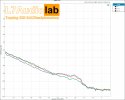partially.That defeats the whole idea of killing differential mode glitches
IRL
- for DACs with not very symmetrical outputs, like PCM179x, this capacitance strongly balances them and reduces THD by 2-3 times
(but some DAC demonstrate no effect, where we loading current output to ground by resistor or capacitor for filtering/damping
but some DAC have strong ultrasonic noise, and we should filtered it before i/v..... compromise is.)
- it part of the low pass filter for i/v
- it part of the RC snubber that prevents oscillations/overshooting at the input of i/v.
when simulating i/v, you need to put not an ideal current source with infinite resistance, but something more realistic. For example, a current source on a field transistor and a pair of protective diodes.


